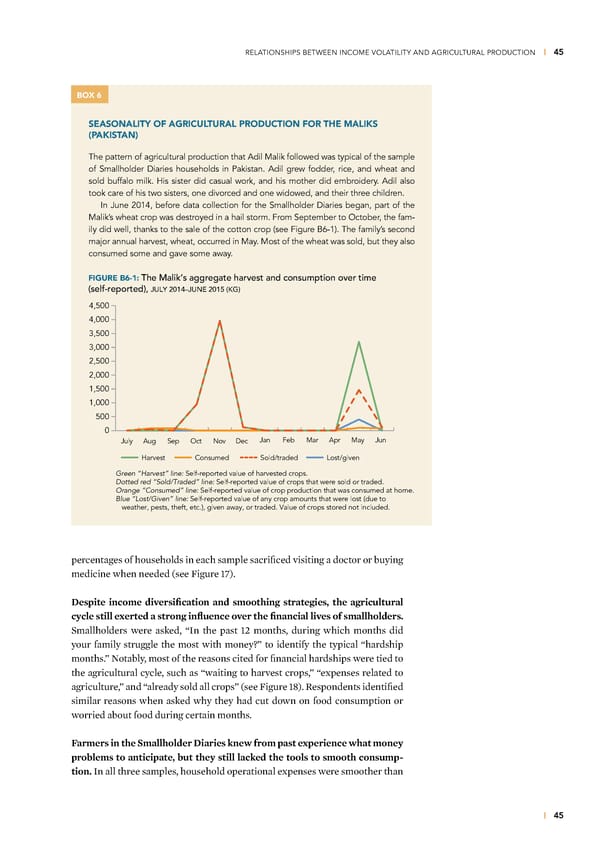RELATIONSHIPS BETWEEN INCOME VOLATILITY AND AGRICULTURAL PRODUCTION | 45 BOX 3BOX 6 SEASONALITY OF AGRICULTURAL PRODUCTION FOR THE MALIKS (PAKISTAN) The pattern of agricultural production that Adil Malik followed was typical of the sample of Smallholder Diaries households in Pakistan. Adil grew fodder, rice, and wheat and sold buffalo milk. His sister did casual work, and his mother did embroidery. Adil also took care of his two sisters, one divorced and one widowed, and their three children. In June 2014, before data collection for the Smallholder Diaries began, part of the Malik’s wheat crop was destroyed in a hail storm. From September to October, the fam- ily did well, thanks to the sale of the cotton crop (see Figure B6-1). The family’s second major annual harvest, wheat, occurred in May. Most of the wheat was sold, but they also consumed some and gave some away. FIGURE B6-1: The Malik’s aggregate harvest and consumption over time (self-reported), JULY 2014–JUNE 2015 (KG) 4,500 4,000 3,500 3,000 2,500 2,000 1,500 1,000 500 0 July Aug Sep Oct Nov Dec Jan Feb Mar Apr May Jun Harvest Consumed Sold/traded Lost/given Green “Harvest” line: Self-reported value of harvested crops. Dotted red “Sold/Traded” line: Self-reported value of crops that were sold or traded. Orange “Consumed” line: Self-reported value of crop production that was consumed at home. Blue “Lost/Given” line: Self-reported value of any crop amounts that were lost (due to weather, pests, theft, etc.), given away, or traded. Value of crops stored not included. percentages of households in each sample sacrificed visiting a doctor or buying medicine when needed (see igure …•) Despite income diersification and smoothing strategies, the agricultural cycle still e‡erted a strong influence oer the financial lies of smallholders Smallholders were ased, “€n the past …‘ months, during which months did your family struggle the most with money?” to identify the typical “hardship months” ˜otably, most of the reasons cited for financial hardships were tied to the agricultural cycle, such as “waiting to harvest crops,” “expenses related to agriculture,” and “already sold all crops” (see igure …¡) ªespondents identified similar reasons when ased why they had cut down on food consumption or worried about food during certain months Farmers in the Smallholder Diaries ƒnew from past e‡perience what money problems to anticipate, but they still lacƒed the tools to smooth consump- tion €n all three samples, household operational expenses were smoother than | 45
 Financial Diaries with Smallholder Families Page 59 Page 61
Financial Diaries with Smallholder Families Page 59 Page 61